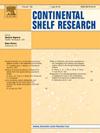西南太平洋新喀里多尼亚狭窄泻湖热带气旋期间珊瑚礁保护对风暴潮的作用
IF 2.2
3区 地球科学
Q2 OCEANOGRAPHY
引用次数: 0
摘要
太平洋岛屿面临沿海灾害,特别是由低压、极端风和海浪引起的风暴潮。虽然珊瑚礁自然地保护海岸线免受入射波浪的影响,但珊瑚礁地貌的多样性引起了各种海岸反应,使基于近海条件的灾害预测复杂化。因此,了解泻湖风暴潮动态对于制定应对全球变暖和海平面上升的适应战略至关重要。本文采用schist - swan耦合环流-波浪数值模式,研究了热带气旋条件下新喀里多尼亚坡窄浅泻湖的风暴潮响应。对2019年气旋季节的回顾显示,最大风暴潮集中在泻湖最狭窄的部分,那里有人类基础设施,增加了对极端水位的暴露。将珊瑚礁结构修改为更不规则的形式表明,宏观尺度的珊瑚礁特征可以减轻波浪设置强度。此外,珊瑚礁顶部的水深变化显著影响波浪的形成,涨潮和退潮之间的差异可达30%。基于258个合成气旋轨迹的更广泛的概括强调,在泻湖内,波浪设置约占风暴潮的70%,在最极端的事件中上升到90%。这些结果表明,波浪的贡献对风暴潮的准确预测至关重要。这些发现为改善面临气候变化的珊瑚礁岛屿环境中的沿海灾害评估、土地利用规划和恢复策略提供了重要见解。本文章由计算机程序翻译,如有差异,请以英文原文为准。
The role of barrier reef protection to storm surge during tropical cyclones in a narrow lagoon, New Caledonia, south west Pacific
Pacific islands are exposed to coastal hazards, particularly storm surges resulting from low pressure, extreme winds, and waves. While coral reefs naturally protect shorelines from incident waves, the diversity of reef geomorphologies induce various coastal responses, complicating hazard prediction based on offshore conditions. Understanding lagoon storm surge dynamics is therefore crucial for developing adaptation strategies to address global warming and sea-level rise. This study investigates the storm surge response of the narrow and shallow lagoon of Poe in New Caledonia using the SCHISM-SWAN coupled circulation-wave numerical model under tropical cyclone conditions. A retrospective of the 2019 cyclonic season shows that maximum storm surge is concentrated in the narrowest part of the lagoon, where human infrastructures are located, increasing exposure to extreme water levels. Modifying the reef structure to a more irregular form reveals that macro-scale reef features can mitigate wave setup intensity. Additionally, water depth variations over the reef crest significantly affect wave setup, with up to 30 % difference between high and low tides. A broader generalization based on 258 synthetic cyclone tracks highlights that within the lagoon, wave setup accounts for approximately 70 % of the storm surge, rising to 90 % during the most extreme event. These results showing that the wave contribution is essential for accurate storm surge prediction. The findings provide critical insights for improving coastal hazard assessment, land use planning, and resilience strategies in reef island environments facing climate change.
求助全文
通过发布文献求助,成功后即可免费获取论文全文。
去求助
来源期刊

Continental Shelf Research
地学-海洋学
CiteScore
4.30
自引率
4.30%
发文量
136
审稿时长
6.1 months
期刊介绍:
Continental Shelf Research publishes articles dealing with the biological, chemical, geological and physical oceanography of the shallow marine environment, from coastal and estuarine waters out to the shelf break. The continental shelf is a critical environment within the land-ocean continuum, and many processes, functions and problems in the continental shelf are driven by terrestrial inputs transported through the rivers and estuaries to the coastal and continental shelf areas. Manuscripts that deal with these topics must make a clear link to the continental shelf. Examples of research areas include:
Physical sedimentology and geomorphology
Geochemistry of the coastal ocean (inorganic and organic)
Marine environment and anthropogenic effects
Interaction of physical dynamics with natural and manmade shoreline features
Benthic, phytoplankton and zooplankton ecology
Coastal water and sediment quality, and ecosystem health
Benthic-pelagic coupling (physical and biogeochemical)
Interactions between physical dynamics (waves, currents, mixing, etc.) and biogeochemical cycles
Estuarine, coastal and shelf sea modelling and process studies.
 求助内容:
求助内容: 应助结果提醒方式:
应助结果提醒方式:


